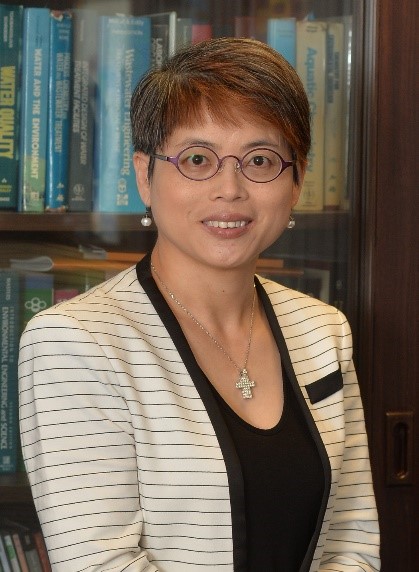
Ir Prof Irene M. C. LO
Academician, M.EASA, FASCE, FHKIE, CAP, JPChair Professor, Department of Civil and Environmental Engineering, The Hong Kong University of Science and Technology, Hong Kong
Speech Title: A Novel Up-scaling Process of a Net-zero Photoelectrochemical System with H2 Generation for Real Saline Sewage Treatment
Abstract: Traditional wastewater treatment plants (WWTPs), relying on the activated sludge process and disinfection process to remove contaminants and inactivate bacteria, have been widely used around the globe to secure water safety and protect natural resources. However, these processes suffer from a plethora of limitations, such as intensive carbon emissions, excessive power consumption, and chemical intensity induced by chemical addition. Aiming to address the limitations of conventional wastewater treatment processes, our research team conducted a series of research to develop a novel chemical-free photoelectrochemical (PEC) system in both batch and large-size reactors for saline sewage treatment to remove multiple contaminants (including organic pollutants, ammonia, and pathogenic microorganisms) coupled with hydrogen generation, reduce energy consumption, and achieve low carbon emissions for wastewater treatment.
The PEC experiments were first conducted in the batch reactor for proving the concept of multifunctional PEC system and revealing the mechanisms. activity of the material for PEC reactions by redistributing electrons and activating oxygenated species in aqueous solutions (Wu et al., 2018; Xiao et al., 2021; Zheng et al., 2022). In our batch PEC reactor, two ports for water sampling and gas collection were also established in the system. In the PEC tests conducted in the batch reactor, 100 mL of simulated sewage or real sewage collected from the local WWTPs was treated at an applied voltage of 2.0 V vs. Ag/AgCl, under solar light illumination with the intensity of 1041 ± 34 W/m2. Outstanding performance was achieved by the developed batch PEC system in terms of simulated sewage treatment. Full degradation of NH3-N and inactivation of E. coli is achieved by the PEC/r-BiVO4 system, while 93.2 % of COD is degraded within 40 minutes. It is notable that, after the PEC treatment of the simulated sewage, the effluent meets the local discharge standards for COD, ammonia-N, and E. coli under 2.0 V vs. Ag/AgCl. To highlight the ability of the PEC system to generate hydrogen gas as potential green energy, it is found that 633.1 μmol of H2 evolved (6.33 mol/m3, equals 0.29 kWh/m3 of electricity) in 40 minutes of PEC reaction.
Our research team is then committed to advancing the multifunctional PEC system for low-carbon-emissions saline sewage treatment from the laboratory-scale study and development phase to industrialization ultimately. After a verification of the feasibility of applying the batch PEC system to real sewage treatment, we fabricated the large-size continuous-flow PEC reactor stepping forward the industrial application of the developed technique. The long-term performance of the PEC system using the large-scale reactor in treating real sewage from the Stonecutters Island WWTP under natural sunlight was evaluated. In order to fully manipulate natural sunlight as the light source for the PEC system, the reactor is equipped with a sun-tracking system.
In comparison to the conventional biological treatment process, the large-scale PEC system achieved significant reductions in greenhouse gas emissions. Specifically, it accomplished a 99.3% reduction in CH4 emissions, and a substantial 93.8% reduction in N2O emissions. Furthermore, the PEC system delivered outstanding environmental benefits, achieving 95.8% reduction in scope 1 emissions, offsetting scope 2 emissions through H2 evolution, and an 95.5% reduction in total carbon emissions.
Biography: Ir Prof Irene Lo, JP is currently a Chair Professor in the Department of Civil and Environmental Engineering at The Hong Kong University of Science and Technology. She is an elected Academician of the European Academy of Sciences and Arts, as well as Elected Fellow of the Hong Kong Academy of Engineering Sciences, Hong Kong Institution of Engineers, and American Society of Civil Engineers. She was appointed by HKSAR Government as Justices of the Peace (JP) in 2017. She was also Adjunct Professor of Tongji University, Tianjin University, Jilin University and Harbin Institute of Technology. She had been Visiting Professor of Technical University of Denmark and the University of Wisconsin at Madison.
She was the recipient of numerous prestigious international research awards, such as 2007 ASCE Samuel Arnold Greeley Award, 2009 ASCE Wesley W Horner Award, and the 2012 ASCE EWRI Best Practice-Oriented Paper Award. In addition, she received the 2019 Higher Education Outstanding Scientific Research Output Awards in the Natural Science/Technology Advancement by Ministry of Education, China. She has been invited to give over 50 plenary/keynote/invited speeches at many international conferences in Asia, Europe, Africa, and North America.
Her research interests include advanced oxidation processes and nanoparticles/nanotechnology for environmental applications. Her citation is 20900+ with H-index 78, as reported by Google Scholar. She was recognized as "Top 2% Scientists in the World” by Stanford university in 2020, 2021 and 2022.
